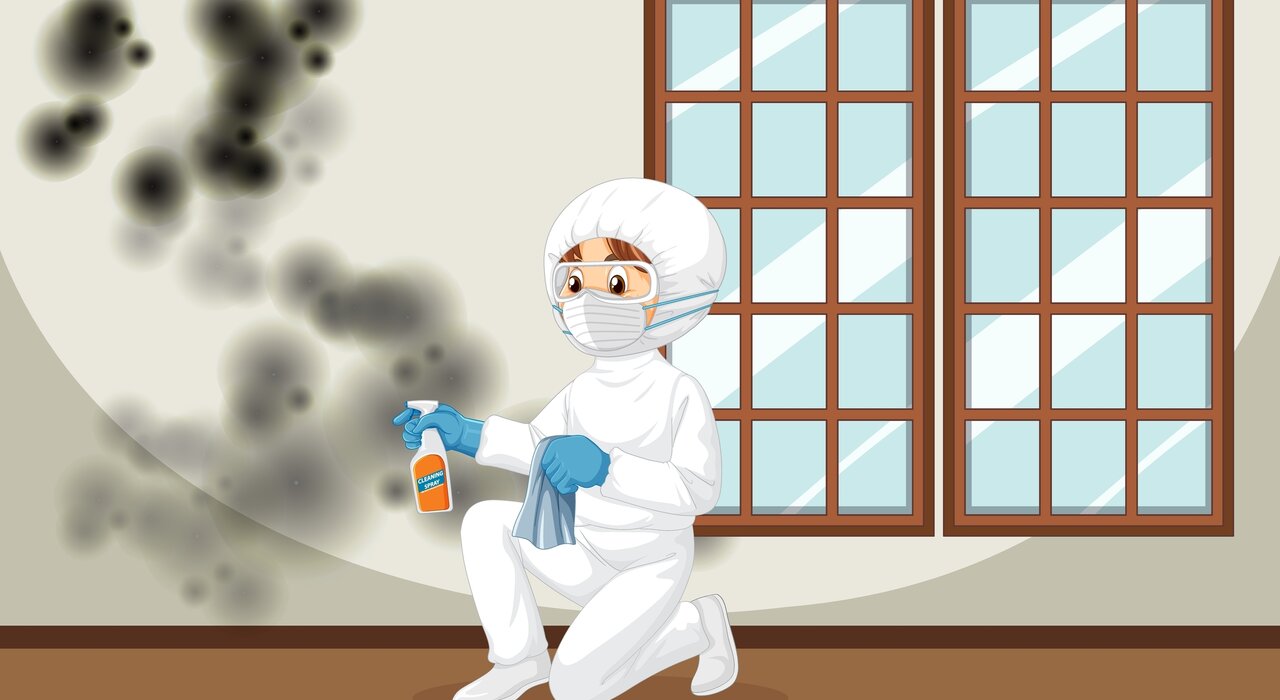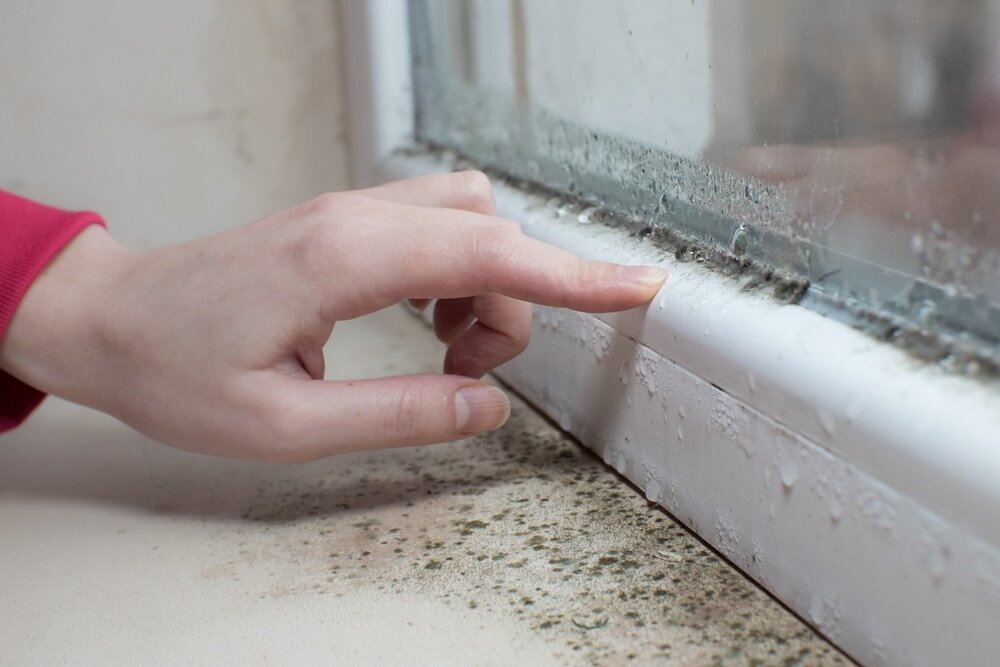
- How does mould occur on walls?
- Environmental conditions
- Water damage
- Humidity and temperature
- Lack of maintenance
- Inadequate insulation and ventilation
- Building materials
- Microclimates
- Interaction with internal factors
- How does condensation affect the formation of mould?
- Types
- Black Mould (Stachybotrys chartarum)
- Green Mould (Aspergillus, Penicillium, Cladosporium)
- White Mould (Acremonium)
- Brown or Yellow Mould (Aureobasidium)
- Orange Mould (Fusarium)
- Preventative measures
- Improve ventilation
- Regulate indoor humidity
- Use water-repellent paint
- Proper drainage
- External Wall Insulation
- Expanded Polystyrene (EPS)
- Mineral Wool
- Kingspan K5
Mould on walls, especially external ones, can be more than just an unsightly nuisance; it poses health risks and can damage the structure of your home. This blog post delves into the reasons mould occurs on walls, the role of condensation, the different types of mould, and how you can address and prevent the problem. We’ll also discuss the role of external wall insulation in mould prevention.
How does mould occur on walls?
Environmental conditions
Mould spores are present in the natural environment and can easily get carried into and around your home through wind, clothes, and pets. However, these spores only become problematic when they encounter favourable conditions for growth, such as moisture, warmth, and organic material to feed on.
Water damage
One of the most common reasons for mould growth on external walls is water damage, often resulting from issues like:
- Leaking Pipes: A leaking pipe within the wall can provide a constant source of moisture.
- Roof Leaks: Poorly maintained or damaged roofs can lead to water seeping into the walls.
- Poor Drainage: Water pooling near the base of external walls can seep into the structure.
Humidity and temperature
External walls are particularly susceptible to changes in weather conditions. High humidity levels, often during rainy seasons, provide ample moisture for mould spores to thrive. Additionally, fluctuating temperatures can cause condensation on the walls, contributing to mould growth.
Lack of maintenance
Not regularly checking and maintaining the external walls of your home can lead to overlooked issues like cracks, peeling paint, or rotting wood—all of which can be gateways for moisture to penetrate the walls.Inadequate insulation and ventilation
Poorly insulated walls can lead to 'cold spots' where water vapour in the air is more likely to condense, providing ideal conditions for mould to grow. Likewise, inadequate ventilation can trap humid air against walls.
Building materials
The type of material that your external walls are made from can also influence mould growth. Porous materials like wood, plaster, or certain types of brick can absorb moisture more readily than non-porous materials, making them more susceptible to mould.
Microclimates
Different areas around the external walls may create microclimates that are more conducive to mould growth. For example, walls that are shaded by trees or adjacent structures may remain damp for longer periods, thus encouraging mould formation.
Interaction with internal factors
Although focusing on external walls, it's important to note that internal factors like poor ventilation, high humidity levels, or even indoor plants close to walls can contribute to mould growth on the external surface. Moisture can travel through wall materials, so an issue on one side can affect the other.
How does condensation affect the formation of mould?
Condensation occurs when warm, moist air comes into contact with a cooler surface, causing the water vapour in the air to condense into liquid water. In the context of external walls, this is particularly likely to happen during the colder months. During winter, the inside of a home is often heated to maintain a comfortable living environment. However, external walls, being exposed to the colder outdoor temperatures, remain cool. When the warm, humid air from the interior encounters these cool external walls, condensation can form, creating a damp surface that serves as an ideal breeding ground for mould spores.
This process is exacerbated by factors like inadequate ventilation and insulation. Poor ventilation traps warm, moist air inside, not allowing for the regulation or escape of humidity. Meanwhile, inadequate insulation makes external walls even more prone to becoming 'cold spots', where the temperature differential between the indoor air and the wall surface is large enough to induce condensation. Both these factors create a vicious cycle: the condensation feeds the mould, and the mould growth, in turn, may lead to further moisture retention, thereby attracting even more condensation.

Types
Black Mould (Stachybotrys chartarum)
Also known as "toxic mould," Black Mould is highly dangerous and should be dealt with promptly. It often appears as dark black or greenish-black in colour and can produce mycotoxins, which can pose serious health risks when inhaled or come into contact with the skin. Black Mould usually requires a water source to grow, so its presence is often indicative of a moisture problem that goes beyond mere condensation.
Green Mould (Aspergillus, Penicillium, Cladosporium)
Green moulds can vary in the risks they pose, but they should nonetheless be removed. They usually appear in shades of green or greenish-black and can sometimes look fuzzy or even slimy. These moulds are common on walls, carpets, and damp wood. Though less toxic than black mould, certain types of green mould can cause respiratory issues and allergic reactions.
White Mould (Acremonium)
White Mould often starts out as small, clear spores that can be easily overlooked. As it grows, it becomes more dense and takes on a powdery, fluffy appearance. While it's generally less toxic than Black Mould, it can still present health risks, especially for those with allergies or compromised immune systems. White mould is often mistaken for efflorescence, a crystal-like deposit that can form on damp surfaces. However, unlike efflorescence, white mould will not dissolve when exposed to water, and it typically has a musty odour.
Brown or Yellow Mould (Aureobasidium)
Typically appearing as brown, yellow, or pinkish spores, this type of mould is most commonly found on wooden surfaces, including external wooden walls. While not as hazardous as black mould, it can still cause respiratory issues and skin irritation. The mould often appears powdery and may darken to a brown or black over time.
Orange Mould (Fusarium)
Orange mould is less common but should be treated with caution. It's often found in cooler, wet areas and can grow on a variety of materials, including wood and wallboards. This mould can cause respiratory issues and allergic reactions, so immediate removal is advised.
[caption id="attachment_69642" align="aligncenter" width="1000"] Black mould[/caption]
Black mould[/caption]
Preventative measures
Preventative measures are essential when it comes to mould, as it's often easier to stop mould from forming in the first place than to deal with its removal and the underlying damage.
Improve ventilation
Installing mechanical ventilation systems such as extractor fans in areas like bathrooms and kitchens can significantly reduce moisture levels. These systems draw out humid air and replace it with dry air, reducing the risk of condensation. Regularly opening windows and using trickle vents can provide natural ventilation, allowing moist air to escape and fresh air to circulate. Creating a cross-breeze by opening windows on opposite sides of a room can be particularly effective.
Regulate indoor humidity
Utilising dehumidifiers can be especially beneficial in regulating indoor humidity levels. Make sure to choose a unit that's appropriate for the size of the area where you plan to use it. These are devices that measure the moisture content in the air. By monitoring humidity levels, you can take action before mould has a chance to grow.
Use water-repellent paint
Water-repellent or mildew-resistant paint can form a protective layer on your external walls, preventing moisture from penetrating the surface. This type of paint often contains antimicrobial agents that inhibit mould growth.Proper drainage
Regularly cleaning and maintaining your gutters can prevent water from overflowing and seeping into your walls. Ensure that the ground slopes away from your home's foundation so that water drains away effectively.
External Wall Insulation
External wall insulation is an increasingly popular solution for preventing mould growth, improving energy efficiency, and enhancing the comfort of a home. Understanding aspects like R-values and material choices can help you make an informed decision. The R-value is a measure of thermal resistance, indicating how well an insulating material resists heat flow. Higher R-values mean better-insulating properties. For external walls, a higher R-value is generally desirable, especially in colder climates, as it reduces the likelihood of 'cold spots' where condensation can form. Insulation with a higher R-value can also contribute to reduced heating and cooling costs.
Expanded Polystyrene (EPS)
- R-Value: Around R-4 per inch
- Pros: EPS is lightweight, easy to install, and relatively inexpensive. It offers a good balance of thermal performance and cost-effectiveness.
- Cons: While it is moisture-resistant to some degree, it may not perform as well as other materials in very wet conditions. It's also less fire-resistant compared to other options.
Mineral Wool
- R-Value: Approximately R-3 to R-3.3 per inch
- Pros: Mineral wool is made from natural materials like basalt or slag wool, making it eco-friendly. It's also fire-resistant and effective at sound insulation.
- Cons: Mineral wool is generally more expensive than EPS and can be more challenging to install. It can also absorb moisture if not properly sealed, which could potentially contribute to mould growth.
Kingspan K5
- R-Value: Around R-5 to R-6 per inch
- Pros: Kingspan K5 is a phenolic foam board with excellent thermal performance, making it one of the most effective materials in terms of R-value. It's also moisture-resistant and lightweight.
- Cons: This material is often more expensive than both EPS and mineral wool. Professional installation is highly recommended due to the material's specific handling requirements.
Regardless of the material you choose, it's crucial to ensure proper installation. Incorrectly installed insulation can create gaps or 'thermal bridges', where heat can escape, reducing the effectiveness of the insulation and potentially leading to issues like mould growth.
